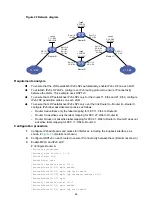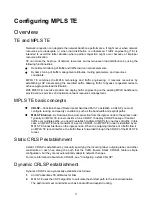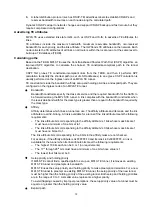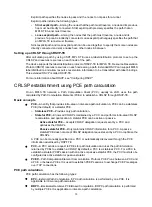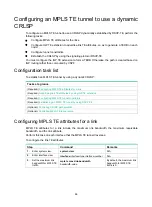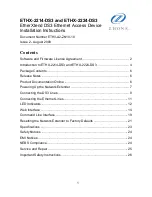
76
•
SE
—Shared-explicit, where resources are reserved for senders on the same session and
shared among them. SE is mainly used for make-before-break.
As shown in
, a CRLSP with 30 M reserved bandwidth has been set up from Router A to
Router D through the path Router A—Router B—Router C—Router D.
To increase the reserved bandwidth to 40 M, a new CRLSP must be set up through the path Router
A—Router E—Router C—Router D. To achieve this purpose, RSVP-TE needs to reserve 30 M
bandwidth for the old CRLSP and 40 M bandwidth for the new CRLSP on the link Router C—Router
D. However, there is not enough bandwidth.
After the make-before-break mechanism is used, the new CRLSP can share the bandwidth reserved
for the old CRLSP. After the new CRLSP is set up, traffic is switched to the new CRLSP without
service interruption, and then the old CRLSP is removed.
Figure 27 Diagram for make-before-break
Route pinning
Route pinning enables CRLSPs to always use the original optimal path even if a new optimal route
has been learned.
On a network where route changes frequently occur, you can use route pinning to avoid
re-establishing CRLSPs upon route changes.
Tunnel reoptimization
Tunnel reoptimization allows you to manually or dynamically trigger the ingress node to recalculate a
path. If the ingress node recalculates a better path, it creates a new CRLSP, switches traffic from the
old CRLSP to the new, and then deletes the old CRLSP.
MPLS TE uses the tunnel reoptimization feature to implement dynamic CRLSP optimization. For
example, if a link on the optimal path does not have enough reservable bandwidth, MPLS TE sets up
the tunnel on another path. When the link has enough bandwidth, the tunnel optimization feature can
switch the MPLS TE tunnel to the optimal path.
Automatic bandwidth adjustment
Because users cannot estimate accurately how much traffic they need to transmit through a service
provider network, the service provider should be able to perform the following operations:
•
Create MPLS TE tunnels with the bandwidth initially requested by the users.
•
Automatically tune the bandwidth resources when user traffic increases.
MPLS TE uses the automatic bandwidth adjustment feature to meet this requirement. After the
automatic bandwidth adjustment is enabled, the device periodically samples the output rate of the
tunnel and computes the average output rate within the sampling interval. When the auto bandwidth
adjustment frequency timer expires, MPLS TE resizes the tunnel bandwidth to the maximum




